In Seocho, one of Seoul's oldest neighborhoods, a maze of
centuries-old homes and rich artistic heritage sustain a charming
urban oasis of calm and reflection.
Peering through the ancient byways of Seochon,you can see both Gyeongbok Palace, the official royal residence of the Joseon Dynasty (1392- 1910), and Cheong Wa Dae, the presidential office, at the foot of Mt. Bugak. It’s this proximity that led to Seochon becoming the centuries-long enclave of officials and scholars, who walked to the palace.
Seochon means “west village,” in reference to its direction from the palace. It hugs the foot of Mt. Inwang, once a defensive barrier when Seoul was a walled city. Amid the COVID pandemic, people who have learned to enjoy solitary hikes up Mt. Inwang love to stand at the top and lose themselves in the view of Seoul spread below.
Seochon is now one of Seoul’s greatest attractions, along with the hanok village Bukchon, meaning “northern village.” Both places are filled with charming alleys lined with traditional-style homes, more than a few of which are hundreds of years old. Many are now stylish cafés, boutique coffee shops and inns. Inside one repurposed hanok is Daeo Bookstore, the oldest secondhand bookshop in Seoul, a few minutes away from Gyeongbok Palace subway station.More importantly, both the Seochon and Bukchon areas have an ambience that’s all about art and culture.
The narrow alleys of Seochon have the warm-hearted air and ease of Prague’s Golden Lane and the feel of the back alleys of Paris’s Montmartre. Besides the repurposed hanok, there are galleries where scenes from the ink-andwash landscapes of the Joseon era now grace the canvases of 21st century artists. A popular rendezvous site here is Tongin Market, where scores of vendors sell everyday wares and eateries beckon with all kinds of delicious food.The market is famous for its lunch-box program; diners exchange a set of coins that are used to buy a wide array of homemade side dishes at little cost.
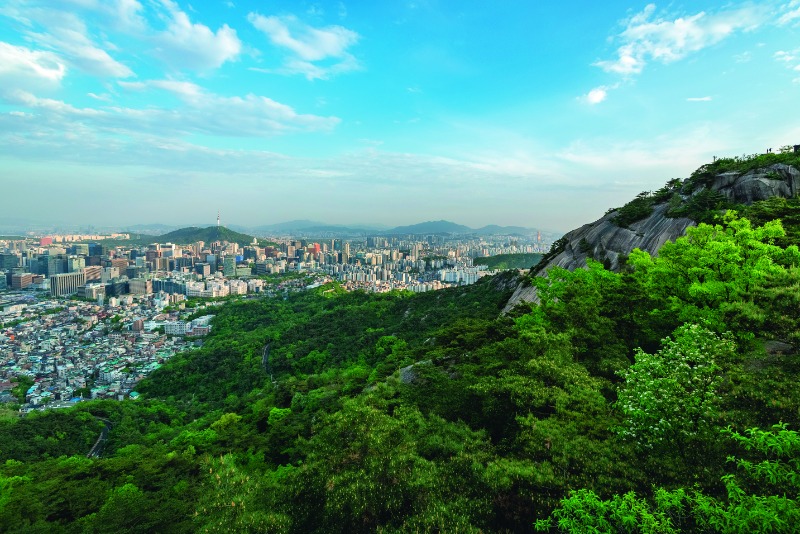
The greatest pleasure of touring the alleys is that your eyes are opened to unfamiliar new paths as you get lost every now and then.
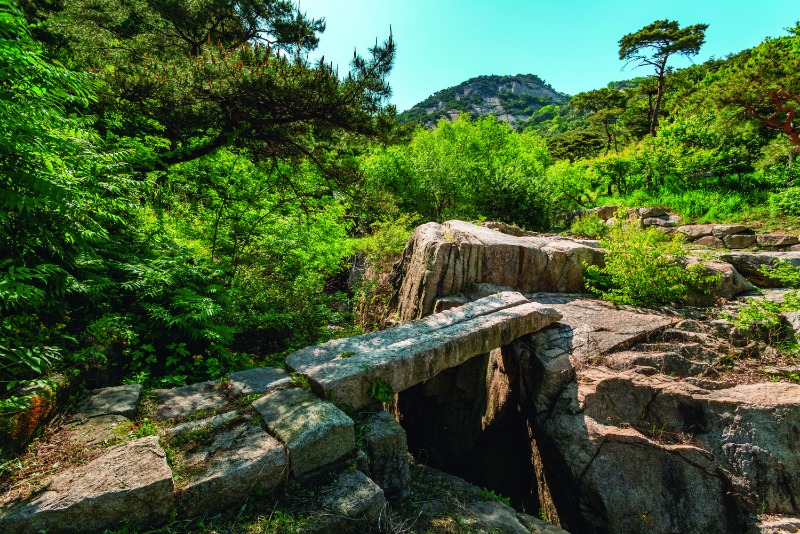
Suseong Valley in Ogin-dong, a picturesque haven famous for its shady trees and the sound of cool running water, has been a longtime favorite of artists.
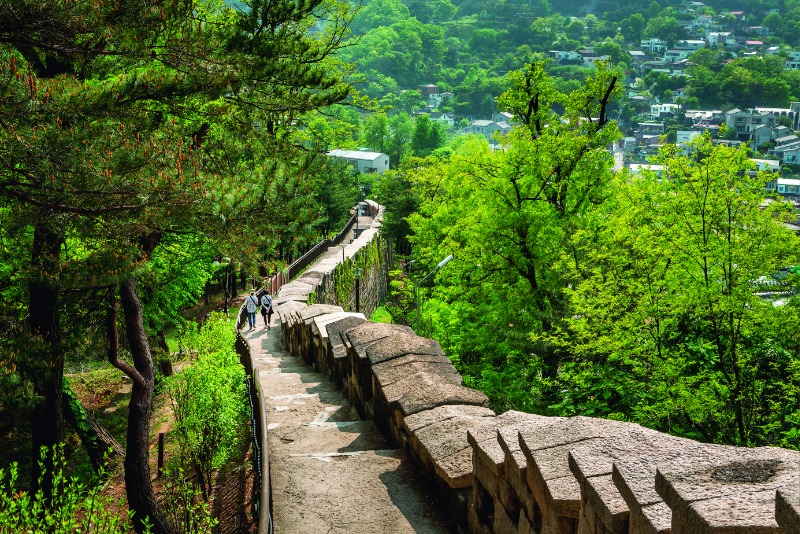
The Seoul City Wall was constructed in the 14th century just after the foundation of the Joseon Dynasty. The defensive barrier stands some 5-8 meters high and is about 18.6 kilometers long. The western section lies on Mt. Inwang with Seochon nestled below.
Celebrated Residents
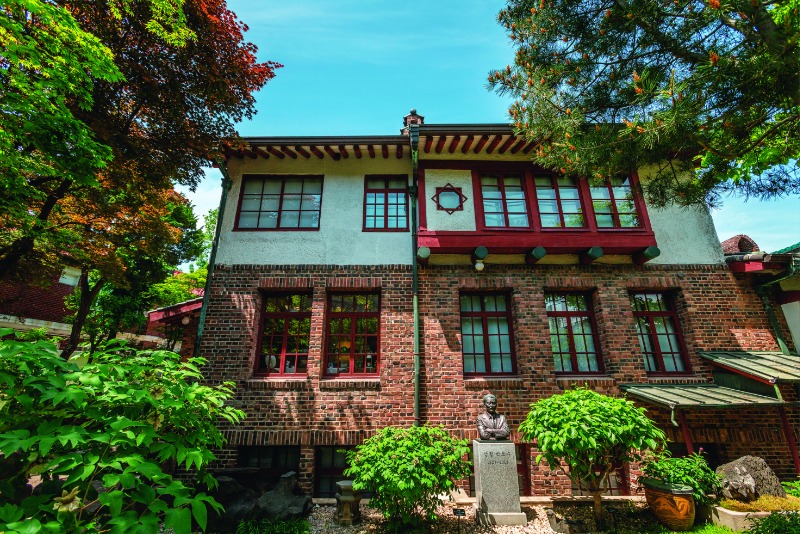
The eponymous museum of artist Pak No-soo opened in 2013. Pak lived at the house for some 40 years and donated some 1,000 artworks to bepreserved and displayed.
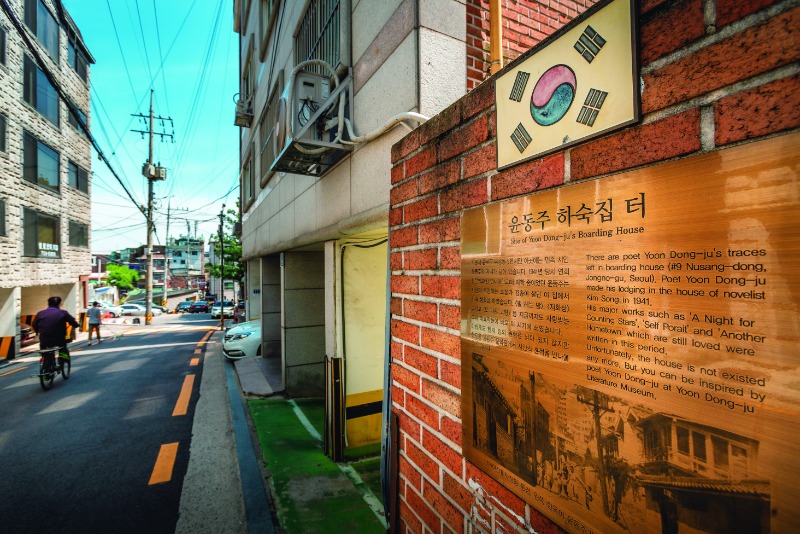
In 1941, Yun Dong-ju, a student at Yonhee College (forerunner of Yonsei University), lived at the home of novelist Kim Song (1909-1988), where hewrote some of his major poems, including “A Night for Counting the Stars.” A plaque marks where the house was located.
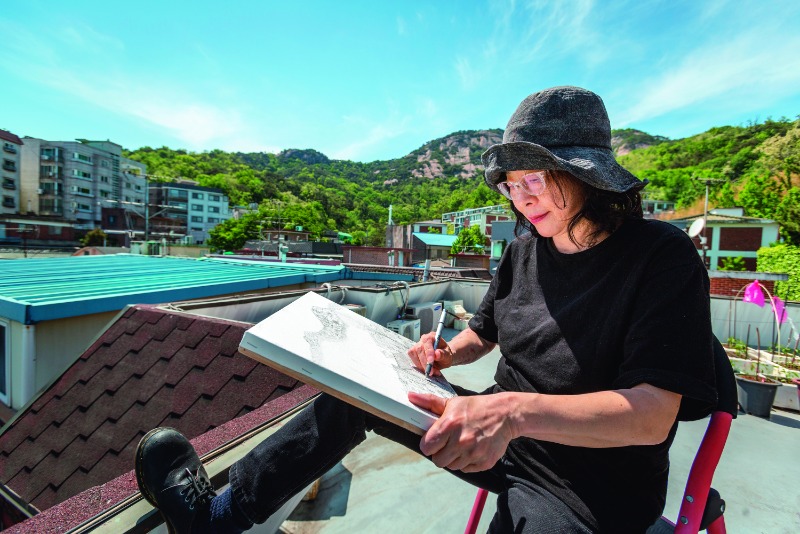
Kim Mi-gyeong takes her ink pens to rooftops and other high places to draw street scenes of Seochon. After a 20-year career as a journalist, she went to live in New York in 2005 and returned in 2012 to settle in Seochon, where she is now known as the “rooftop artist.”
Seochon is where many princes were born and raised, including Prince Chungnyeong, the third son of King Taejong, who would later become King Sejong (r. 1418-1450), the most famous Joseon monarch. He instituted the Korean script and a great deal of scientific research.
King Sejong’s third son, Prince Anpyeong (1418-1453), lived in Suseong Valley in Ogin-dong, the uppermost part of this neighborhood and the setting of “Dream Journey to thePeach Blossom Land,” painted by An Gyeon in 1447. This famous painting depicting the Daoist utopia was inspired by the prince’s dream.
Another royal resident of Seochon was King Sejong’s second-oldest brother, Prince Hyoryeong (1396-1486), a man of great learning and virtuous character. He escapedfrom power politics when his younger brother ascended the throne, and was revered for his efforts to revive Buddhism.
In the same neighborhood, Jeong Seon (1676-1759)painted “Clearing after Rain on Mt. Inwang” (1751), a masterpiece from the cultural heyday of Joseon, the age of theso-called “true view” realist landscapes. This celebrated artwork, designated Korea’s National Treasure No. 216, was part of the private collection of Lee Kun-hee, the late chairman of Samsung Group. It was donated to the state after the business leader passed away in 2020.
In the mid-Joseon period, Seochon began to be inhabited mostly by jungin, literally the “middle people,” a class of lower officials and technicians who ranked between nobility and commoners. Technical workers who ranged from interpreters and doctors to eunuchs who served in the palace made their home in the area, which encompasses today’s Ogin-dong, Hyoja-dong and Sajik-dong. Bukchon was a neighborhood of literati, and the old houses there are relatively large and grand. In contrast, the traditional houses of Seochon are small and modest, which explains the web-like spread of numerous little alleys.
With Joseon’s demise in 1910 and the subsequent Japanese occupation, young artists began to move to Seochon. Major figures included the poets Yi Sang (1910-1937),Yun Dong-ju (1917-1945) and Noh Cheon-myeong (1911-1957), as well as novelist Yeom Sang-seop (1897-1963).Among their neighbors were painters Gu Bon-ung (1906-1953), Lee Jung-seop (1916-1956) and Chun Kyung-ja (1924-2015). Ironically, Seochon is where the luxurious Western-style estates of infamous pro-Japanese figures Lee Wan-yong (1858-1926) and Yun Deok-yeong (1873-1940) were also located.
The passage of art and culture through time, as it is enjoyed and understood in the present, may be compared to a chick breaking out of the darkness in its shell and being born into the world. Like the baby bird chipping away at the hard shell surrounding it in order to live, the artists of modern Korea plunged themselves into creative activity as an escape from the poverty and despair of the times. I set out to discover their traces in Seochon.
Following the Fragrance
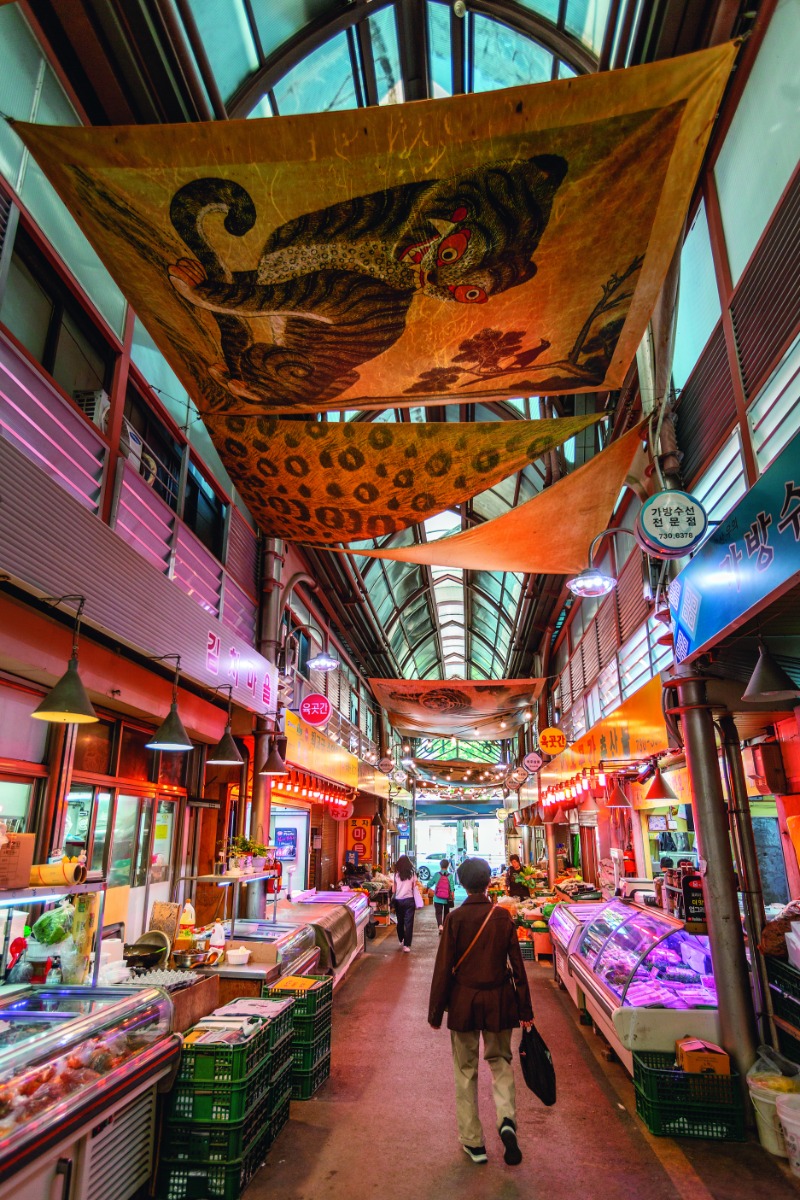
Tongin Market was originally established in 1941 as a public market for Japanese residents in the nearby areas. The market developed into itscurrent form after the Korean War when the population of Seochon expanded rapidly.
First, I headed to Poet’s Hill in Cheongun-dong to see Cheongun Literature Library and Yun Dong-ju Literature House. From the hill, I could see the old city center of Seoul spread out below, and in the distance, beyond Namsan Tower and the Han River, the 123-story Lotte World Tower came into view. The hillside Cheongun Literature Library consists of several lovingly restored hanok, but Yun Dong-ju Literature House is a concrete structure with an iron door somewhat like a prison. And yet, with its lovely outdoor garden café, it ranked high on the 2013 list of “Korea’s best contemporary architecture,” selected by theDong-A Ilbo and the architecture magazine, Space.
In the video room, the life of Yun Dong-ju unfolds on the concrete wall – the time he spent composing poetry in a boarding house in Seochon; his imprisonment in Fukuoka,Japan for participating in anti-Japanese activities by Korean students; and his eventual death there of mysterious causes in February 1945, months before Korea’s national liberation. A journal entry reads, “I hide away in a dark, small room unable to do anything but write poems, ashamed that I am unable to take up arms and fight. I am all the more ashamed as those poems come to me so easily.”
Leaving the maze of alleys behind, I headed for the House of Yi Sang, the genius poet and novelist who died so young. This is a popular starting point for walking tours exploring the art and culture of Seochon. However, thehouse where Yi lived for 20 some years from when he was adopted at the age of three was rebuilt after his death. On display here are Yi’s original handwritten manuscripts andother literary materials. From there, I walked in the direction of Suseong Valley and soon found Pak No-soo Art Museum, which exhibits the works of the modern artist whopainted coolly elegant landscapes. A little further up is the site of the house where poet Yun Dong-ju boarded as a university student.
Finally, I reached Suseong Valley, which could be called the end of Seochon. There, I ran into a woman sitting alone, wearing a mask and working on a drawing. It was KimMi-gyeong, Seochon’s acclaimed “rooftop artist.” Formerly a newspaper reporter with a 20-year career, she quit her job and in 2013 began drawing scenery around Seochon.
From Mt. Inwang and from the rooftops of the hanok, Japanese-style houses from the colonial period and other dwellings around Seochon, Kim captures the urban landscapes of this old neighborhood that she considers to encapsulate an important aspect of the history of Seoul. In the early days, the locals would report her as “a spy making maps.” But now, her drawings can be seen on the walls of many stores in the neighborhood.
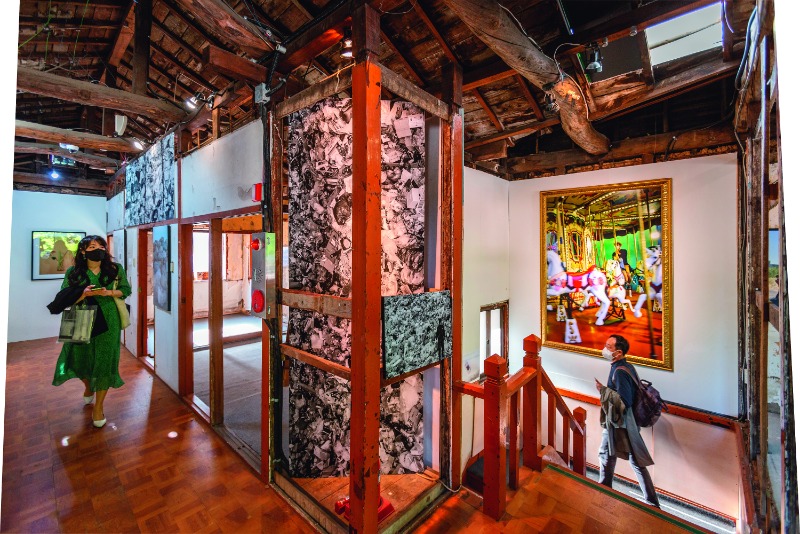
The exhibition “Record of the Streets,” organized by the Korean Safety Health Environment Foundation, was held from April 30 to May 16, 2021 at Boan 1942, a multipurpose cultural venue. It featured some 80 photographs showing ways the COVID pandemic has changed society.
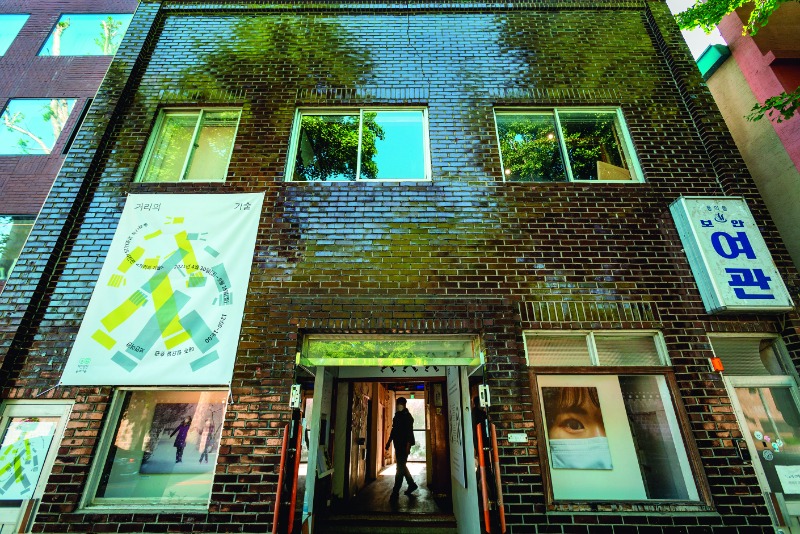
Boan Inn, built in the 1940s, was a popular residence for many artists and writers. Having operated as an inn until 2004, it was recently turnedinto Boan 1942, where exhibitions, performances and other events are held.
The greatest pleasure of touring the alleys is that your eyes are opened to unfamiliar new paths asyou get lost every now and then.
Rescanning the Maze
Rounding off my trip, I stopped by Boan Inn in Tonguidong, where painter Lee Jung-seop, poet Seo Jeong-ju (1915-2000) and other writers and artists often stayed. The original building has been preserved and transformed into an exhibition and cultural venue named Boan 1942. It was here that Seo and other poets d the coterie magazine, “Poets’ Village” (Siin Burak), in 1936. Traces of the past can be found throughout the building. I welcomed the creaky wooden stairs and was glad that the closely packed, 1 cramped exhibition rooms retained their old charm.
Choi Seong-u, who runs Boan 1942, dreamed of being an artist and went to France to study. He ended up studying art administration, and upon his return, turned the old Boan Inn into a multipurpose cultural center. He expanded the space by erecting a building next door, showing not only the works of experimental young Korean artists but also actively pursuing international projects.
Residents of Seochon have varied over several centuries. But the threadthem has always been art and culture, remaining palpable in the meandering alleys today.
The greatest pleasure of touring the alleys is that your eyes are opened to unfamiliar new paths as you get lost every now and then. Sometimes, the alleys suddenly stop in dead ends, and as you turn and look back, you begin to think about the traces of your own life. On this outing to Seochon, I frequently looked back again and anew.
Kwon Oh-nam has operated Daeo Bookstore since she opened it with her late husband in 1951, when they decided to use part of their traditional-style home as a book shop. It is now the oldest secondhand bookstore in Seoul, and also functions as a book café.
Chebu-dong, a famous foodie haunt, attracts people of all ages who search for tasty food day and night. The small eateries are crowded together to form a veritable wall in a maze of alleys.